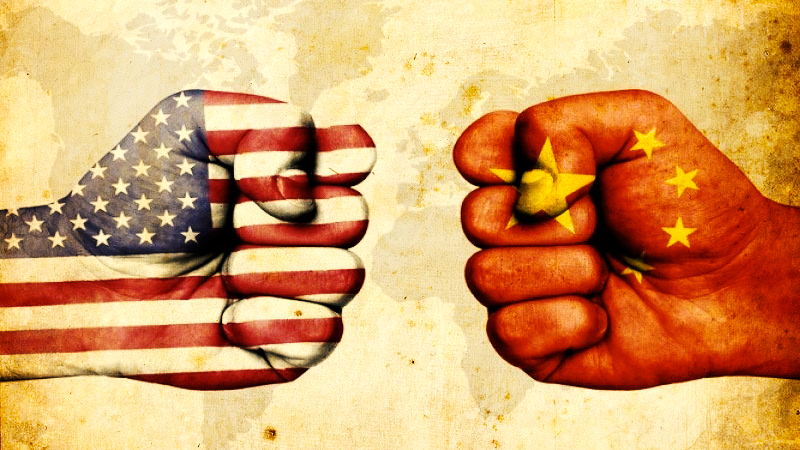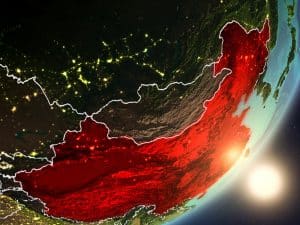Every time the negotiations between the United States and China break down and the prospects for a trade war look more ominous, stock markets fall and mainstream economists warn about the irreparable harm of such a development. With the exception of some specific companies or industries, no one in the United States really seems to like the scenario of an all-out trade war with China. Most of the largest American firms either depend on cheap Chinese manufacturing or seek to deepen, not sever, economic ties with China so as to sell in the Chinese domestic market.
Take the example of Apple: Although its products are designed in the United States, all its products are manufactured abroad, most of them in China. A significant increase in tariffs on Chinese products would inevitably hinder Apple’s capacity to compete with other tech giants, like South Korea’s Samsung.
But that’s not all. American consumers would be affected by rising prices, as Trump administration officials were forced to admit. The standard of living of working-class Americans would take a hit if cheap goods coming from China are no longer available. Of course, Chinese companies would be hurt too.
So if no one benefits from a protectionist escalation, why is Trump so dead-set on pursuing it? What’s really behind the tariff increase and the threats of a trade war is not really the renegotiation of commercial balance with China, as Trump usually presents it; it’s a push to break open China’s domestic market to American firms and, simultaneously, a battle between China as a rising world power and the United States as a declining world hegemon. At the center of the battle is the fight for technological supremacy, including not only the large-scale production of high-value-added consumer goods but also the development of artificial intelligence (AI) and communication infrastructure (fiber-optic and 5G), as well as the sensitive realm of cyber security.
Development and Global Division of Labor
Modernization theory was popularized by mainstream economists and social scientists in the 1950s and 1960s. The theory’s main idea was that all countries could develop successfully as long as they followed the correct recipe: promoting Western values, liberal democracy and free trade. The reality, however, was the opposite. An international division of labor had already taken shape, and the “first-movers,” those countries that had industrialized and reached a certain development, kept running ahead while “underdeveloped countries” kept lagging behind.
Alternative theories tried to explain this increasing divergence. The Dependency school emerged as an attempt to explain—in the words of Samir Amin and André Gunder Frank—the “development of underdevelopment.” Although theories in this school of thought differed substantially, they all emphasized the “unequal exchange” in international trade, or the idea that labor in low-income countries is paid much lower than in high-income countries, thus reproducing wealth and accumulation on one side and poverty and backwardness on the other. Whatever the mechanism, semicolonial countries have been locked in place in the world economy since the end of War World II—with very few exceptions.
China, however, broke the mold and, beginning in the 1990s, experienced unprecedented growth. The numbers are astounding. China’s GDP increased 30-fold, from $360 billion in 1990 to $12 trillion in 2017 (U.S. GDP grew three times in the same period, from $6 trillion to$9 trillion) and experienced a breakneck industrialization process. It is difficult to pinpoint why China accomplished this, but we can point out some exceptional circumstances.
China’s Extraordinary Rise
When Chinese leader Deng Xiaoping implemented a set of policies that opened up the Chinese economy, global capitalism was slowing down after the decades-long second postwar boom. The incorporation of the Chinese labor force into the global economy provided an immense outlet for capitalist accumulation. Multinational corporations flooded the first Special Economic Zone (SEZ) in Shenzhen and later continued flocking to the SEZs that mushroomed across coastal China. The reasons are obvious. Labor costs were ridiculously cheap and appeared inexhaustible: As foreign capital flew in, the Chinese rural population replenished the labor market in the burgeoning coastal cities.
The spectacular growth of the Chinese economy can be understood only in relation to the United States. After the second postwar boom came to an end and neoliberalism set in, and particularly after China entered the World Trade Organization (WTO), China and the United States developed a symbiotic relationship (sometimes called “Chinamerica”): The United States exported capital to China and imported cheap commodities, while China funded the United States’ deficit by buying Treasury bonds. At the same time, large trade surpluses and increasing foreign-exchange reserves allowed the Chinese government to lend massively and thus play a key role in developing its domestic industry. China’s rise can therefore be seen as a byproduct of American capital’s necessity for global expansion.
Today there are an estimated 270 million Chinese “migrant workers,” who had to move from the countryside to the city in search of opportunities and were stripped of many of their rights by the hukou system of household registration. To be sure, at some point the labor market started tightening up, labor costs began to increase and, following a pattern described by Beverly Silver in “Forces of Labor,” within a generation after new capital landed in the region, labor unrest emerged. But before this became a disincentive for foreign capital, the incomparably large pool of cheap labor allowed China to absorb foreign direct investment (FDI) for decades, allowing the country to become a manufacturing powerhouse.
China’s entry to the WTO elicited a new flood of investments, and as industrialization advanced, China developed its own domestic capital. This process was facilitated by the transfer of technology, design and production techniques from foreign companies to domestic ones, promoted by a strict set of government requirements on foreign investment. From 2000 to 2016, China dramatically increased the export of high-value-added goods while growing its production of simple manufactures.
By the 2010s, China was an integral part of innumerable global value chains. At the same time, industrialization created a massive working-class and middle-class layer, whose living standards had notably improved from those of a previous generation: The domestic demand for consumer goods skyrocketed. Today, the Chinese domestic market is an immense source of profits that all foreign companies want to penetrate, but despite China’s incorporation into the WTO in 2001, the Chinese government has restricted access to it.
The Thucydides Trap
In this context, the tariffs levied by the U.S. government on Chinese goods can be interpreted as a weapon to force China to open its domestic market, but also, importantly, as a means to hamper China’s ascent. According to different analysts, the real fight is for technological supremacy, particularly for the spread of 5G, AI and cybersecurity.
It is estimated that 5G will increase the speed of data transfer by 10 times (some say even 100 times), revolutionizing not just our communications and entertainment possibilities but also allowing for a breakthrough in technological innovation. China is leading the spread of 5G globally, with a significant advantage over the United States in Europe and Latin America. For this reason, Huawei, the company building the 5G infrastructure, has become Trump’s main target, because if the trend continues, China will control the world’s most advanced communications network in the near future. Furthermore, a technological edge translates into a concrete advantage in the potential for developing military power.
The “Thucydides trap” refers to the inevitability of a clash between a rising power that threatens to supersede an established hegemon. China’s explosive growth and technological development puts it on a collision course with the United States for economic, political and military hegemony. But despite commercial expansion and impressive technological advances, China has yet to assert its military dominance in its own backyard, where it faces strong American allies, such as Japan and South Korea, and a heavy presence of the United States military. In any case, the battle for global hegemony will not be resolved peacefully, even if it may take long to be settled.
What Next?
Trump’s decision to blacklist Huawei prevents U.S. companies from selling components and software to the Asian technological giant, a move that could disrupt the company’s production and services. Google, which produces the operating system for all Android cell phones, has announced that it will comply with the ban as soon as the 90-day grace period ends. The delay in implementation gives the United States and China room for negotiations.
The decision to attack Huawei can be interpreted as a push by the U.S. government to force China to grant American internet giants like Google and Facebook access to its domestic market. So it makes sense for tech giants to rally behind the United States ban on Huawei. The world’s largest chip producers, Intel and Qualcomm, have also announced that they will not sell to Huawei. But the pressure on European partners to implement a similar policy has not been successful so far. Neither the UK nor Germany has given any clear sign that it will follow the United States’ lead in blocking the Chinese company.
In sum, the United States is trying to use its economic and political leverage to block the spread of Chinese technology and to force the country to open its domestic market. But the measure raises important tensions in a world that is crisscrossed by hundreds of value chains involving several countries. China depends much more on exports to the United States than vice versa, and it is thus more immediately vulnerable to an escalation in tariffs. Yet China has no lack of resources to counter the American offensive. A Chinese retaliation against American companies such as Apple would not only disrupt many of its production lines but curb its sales in the Chinese market (which amounted to 15% of Apple’s total sales in 2018). In addition, China could use its leverage as the world’s main producer of rare earths—a vital component of virtually all technological products—and supplier for tech companies around the world, including the United States.
On top of this, China has a nuclear option: the sale of U.S. bonds. China holds $1.121 trillion in Treasury bonds. Dumping a large portion of them could have a catastrophic effect on the U.S. economy. It is, however, difficult to predict the consequences of such a move, not least for the Chinese economy itself: It could sink the whole globe in an economic depression.
Politics Drive Economic Policy
Beyond the fight for global supremacy, actions on both sides are conditioned by the political conjuncture. As is well known, Trump is using the tariffs as a political offering to his nationalist base and particularly to those who have seen their living standards fall over the years, blaming it on China and other foreign countries. On the other hand, Chinese leader Xi Jinping presents himself as the champion of Chinese interests in the face of the U.S. imperialist attacks. Both sides know, however, that they are playing with fire. Stock markets tremble every time negotiations break down, and economic losses are already evident on both sides.
It is unclear why negotiations broke down in mid-May. Trump accused China of backpedaling on its commitment to guarantee stricter intellectual property protections to American capital investing in China. This is a plausible reason for the breakdown, since an important concession in this field could be read inside China as weakness on the part of Xi, or even on the part of the Chinese Communist Party, and it could undermine their legitimacy on the domestic front. Another hypothesis is that it was Trump who changed his mind after unexpected economic growth was reported in the first quarter of 2019. The latitude with which Trump can push for more concessions from China depends to a large degree on U.S. economic stability. With an eye to the 2020 elections and emboldened by larger than expected economic growth, Trump’s team likely deemed it relatively safe to toughen up and push for more against China. More recently, however, a less optimistic prognosis of the U.S. economy moved the Fed to entertain interest rate cuts to counter a possible slowdown.
The recent threat of tariffs on Mexican products to force stricter immigration policies blatantly shows how the Trump administration uses the global weight of the U.S. economy (and military) to bully minor partners. The case of China is different, though. The Asian country has grown too big already, and, short of a trade agreement, an increasing escalation of tariffs could be met with retaliatory protectionism and an overwhelming pressure on trade partners to pick sides. Regardless of Trump’s intentions, we can’t rule out that an escalation of hostilities between the two powers could create a new cold war, with two camps thoroughly integrated but separated from one another, parallel communications networks and trade flows, and even two separate cyberspaces, each of them dominated by a different gendarme. In such a scenario, any incident in a third country could serve as an excuse for a proxy war.
The comparison with the Cold War, however, needs some qualifications. While trade between the Soviet Union and the United States reached only about two billion dollars per year, the commercial exchange between China and the United States now amounts to an estimated two billion dollars per day. Moreover, whereas the Soviet Union represented a different economic system (a planned economy, albeit thoroughly bureaucratized), the battle between the United States and China is a competition between two capitalist powers. The future of capitalism is not really at stake, so there is more room for common ground between the rival powers.
The United States’ goal is to put China in its place, relegate it to the level of a second-class country and break open its domestic market for the profit of American (and other transnational) firms. China will not accept this without a fight. A challenge to United States’ hegemony, however, will be met with fire and fury—a trade war would only be the beginning.
The author thanks Paula Bach for her feedback on an earlier draft of this article.











